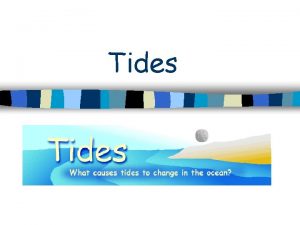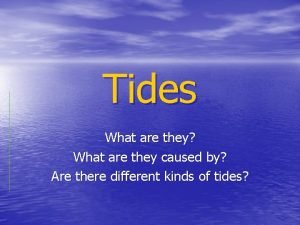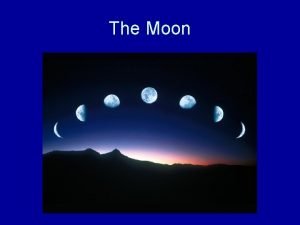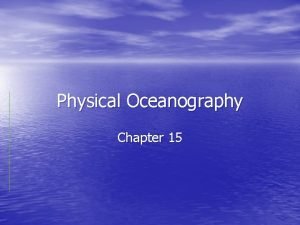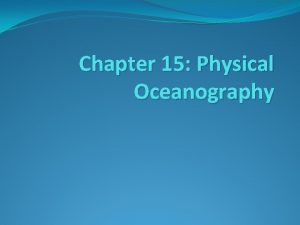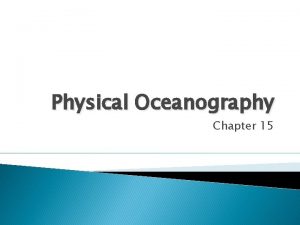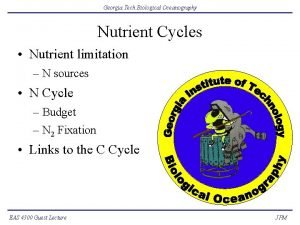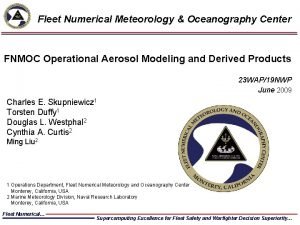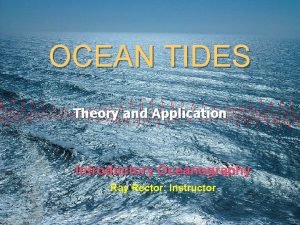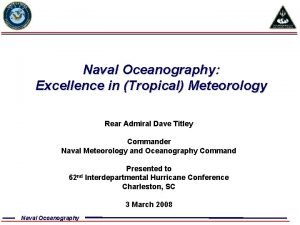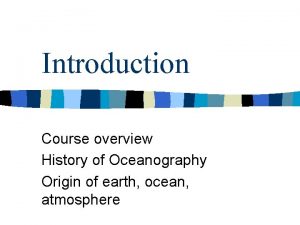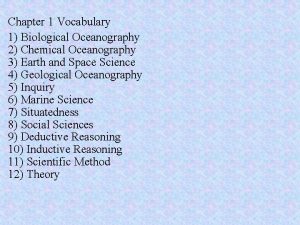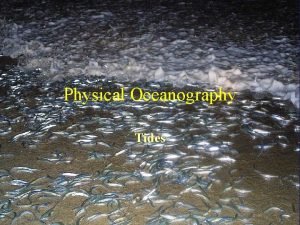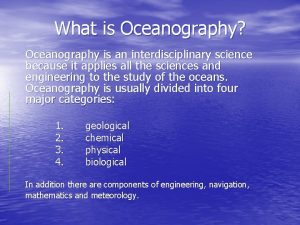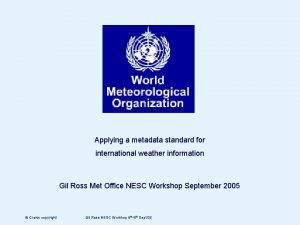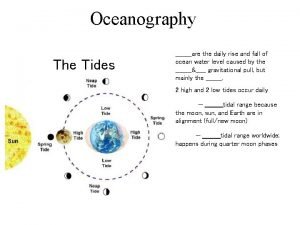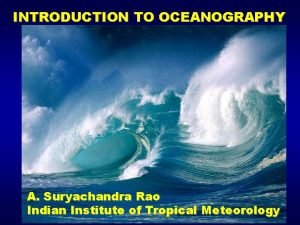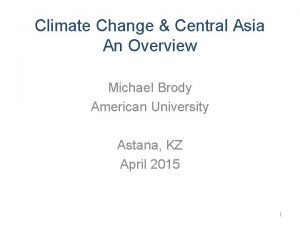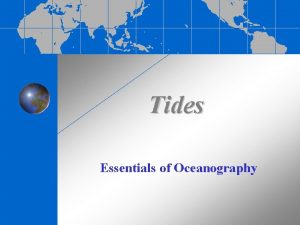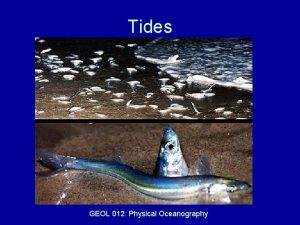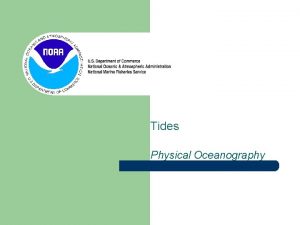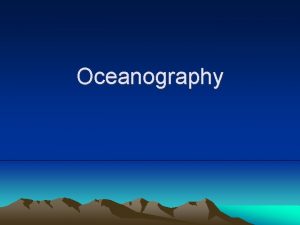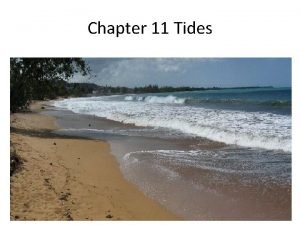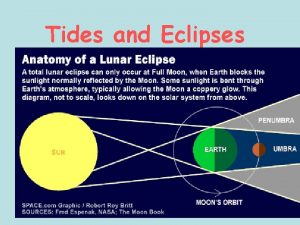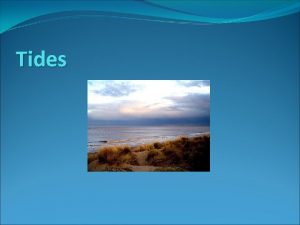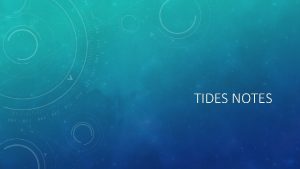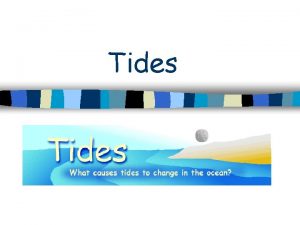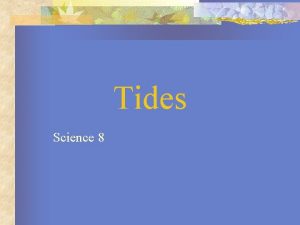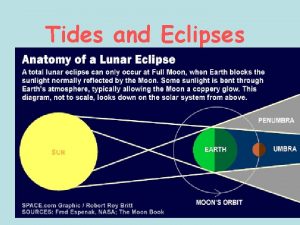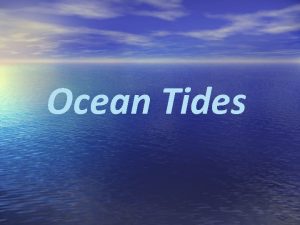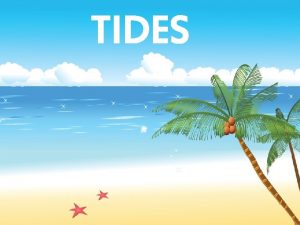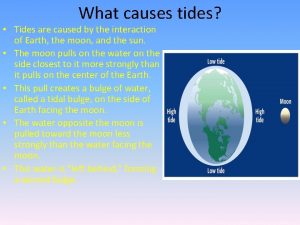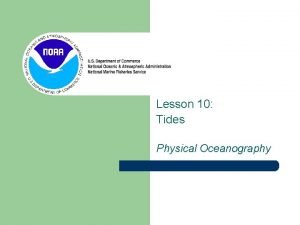Physical Oceanography Tides 1 33 Tides are caused
































- Slides: 32

Physical Oceanography Tides 1 / 33

Tides are caused by the gravitational force of the moon and sun and the motion of earth. The wavelength of tides can be half the circumference of earth. Tides are forced waves because they are never free of the forces that cause them. 2 / 33

The Equilibrium Theory of Tides 3 / 33

Moon Tide Produced by the moon’s gravitation force on water A bulge of water is created by the moon’s gravitational force Centrifugal forces produces a bulge on the opposite side of the Earth & an area of low water between the tidal bulges 4 / 33

Source: 1 5 / 33

7 / 33

Spring Tides • During the period of a new moon, the moon and sun are lined up on the same side of the Earth • Produces the greatest range between high water and low water 8 / 33

Neap Tides • Produced when the moon is at a right angle to the line of centers of the Earth and the sun • The range between high and low water is small 9 / 33

Tide Patterns • Diurnal tide – One high and one low tide per day • Semidiurnal – Twice occurring high and low tide sequences – High and low tides are both at the same level • Semidiurnal mixed tide – Each high tide reaches different heights – Each low tide falls to different levels 10 / 33

Tide Patterns The worldwide distribution of the three tidal patterns. 11 / 33

Tide Patterns 12 / 33

Tide Patterns Examples of monthly tidal curves Top: Boston, Massachusetts, showing semidiurnal tidal pattern. Upper middle: San Francisco, California, showing mixed tidal pattern with strong diurnal tendencies. Bottom: Pakhoi, China, showing diurnal tidal pattern. 13 / 33

Tide Patterns • Amphidromic Points – A "no-tide" point in an ocean – About a dozen amphidromic points exist in the world ocean. – Sometimes called a node. 14 / 33

Amplitude is indicated by color, and the white lines are cotidal differing by 1 hr. The curved arcs around the amphidromic points show the direction of the tides, each indicating a synchronized 6 hour period. R. Ray, TOPEX/Poseidon: Revealing Hidden Tidal Energy en: GSFC, en: NASA 15 / 33

Tides in a Confined Basin • Tidal ranges vary across the ocean basin • Largest variations occur at the edges – Especially in bays and inlets – Energy is concentrated in a small area • A mini amphidromic system develops • Extreme tides in areas where there are natural oscillation periods of 12 or 24 hours 16 / 33

. Tides in Confined Basins The tidal range is determined by basin configuration 17 / 33

Tides in Confined Basins Tides in a narrow basin. Note that a true amphidromic system does not develop because space for rotation is not available. 18 / 33

The largest tidal range in the world occurs in Nova Scotia's Bay of Fundy. Even thought the maximum spring tidal range at the mouth of the bay is only 2 meters (6. 6 feet), amplification of tidal energy causes a maximum tidal range at the northern end of Minas Basin of 17 meters (56 feet), often stranding ships. 19 / 33

Bay of Fundy, High Tide Bay of Fundy, Low Tide 20 / 33

Tides in a Confined Basin • Tidal Bore – A high, often breaking wave generated by a tide crest that advances rapidly up an estuary or river – Occurs in inlets and some rivers exposed to great tidal fluctuations – A true tidal wave 21 / 33

Tide Levels • High water – Greatest height that the tide reaches in a day • Low water – Lowest level that the tide reaches in a day • Mixed tide systems – – Higher high tide Lower high tide Higher low tide Lower low tide 22 / 33

Tide Levels • Mean tide – Calculated by taking the average of all the changes in water level over several years • Flood tide – Tide is rising • Ebb tide – Tide is falling 23 / 33

Tidal Currents • Mass flow of water – Ebb current – Flood current – Slack water 24 / 33

Tides and Marine Organisms • Intertidal Zone – Where the land sea meet, between the high and low tide zones. – Organisms that live here adapted to huge daily changes in moisture, temperature, turbulence (from the water), and salinity. 25 / 33

Tides and Marine Organisms • Grunions! (Leuresthes tenuis) – Spawn from late February to early September 26 / 33

Expected Grunion Runs for 2005 CLOSED SEASON OBSERVATION ONLY OPEN SEASON May June 10 11 12 13 25 26 27 28 Tu 10: 45 PM - 12: 45 AM* We 11: 20 PM - 1: 20 AM* Th 12: 00 AM* - 2: 00 AM* Fr 12: 45 AM* - 2: 45 AM* We 10: 45 PM - 12: 45 AM* Th 11: 35 PM - 1: 35 AM* Fr 12: 35 AM* - 2: 35 AM* Sa 1: 50 AM* - 3: 50 AM* 8 We 10: 25 PM - 12: 25 AM* 9 Th 11: 00 PM - 1: 00 AM* 10 Fr 11: 40 PM - 1: 40 AM* 11 Sa 12: 20 AM* - 2: 20 AM* 23 Th 10: 40 PM - 12: 40 AM* 24 Fr 11: 35 PM - 1: 35 AM* 25 Sa 12: 30 AM* - 2: 30 AM* 26 Su 1: 35 AM* - 3: 35 AM* Where the time relating to the expected run is after midnight, the date of the previous evening is shown. - http: //www. dfg. ca. gov/mrd/gruschd. html 27 / 33

Tidal Power • Tidal energy can be exploited in two ways: – By building semi-permeable undersea tidal turbines across estuaries with a high tidal range. – By harnessing offshore tidal streams 28 / 33

Tidal Power • Water flow as basin fills or empties drives turbines • Similar to a wind turbine, but goes in both directions • Requires a daily tidal range of 5 -7 meters (~1521 feet) • Characterized by low capacity factors, usually in the range of 20 -35%. 29 / 33

List of World Main Tidal Power Stations Country Power Station Tidal Loss (m) Capacity (MW) Operated Since France Langce 8. 5 240 1966 Canada Andeboriece 7. 1 1984 Former Soviet Union China Gicelaya 3. 9 0. 4 1968 Jiangxia 5. 1 3. 2 1980 China Baishakou 2. 4 0. 64 1978 China Xingfuyang 4. 5 1. 28 1989 China Yuepu 3. 6 0. 15 1971 China Haishan 4. 9 0. 15 1975 China Shashan 5. 1 0. 04 1961 China Liuhe 2. 1 0. 15 1976 China Guozishan 2. 5 0. 04 1977 30 / 33

Tidal Power • La Rance, France - world's first tidal power plant – Average tidal range 27 feet – Dam encloses 8. 5 sq. miles – Capacity is 320, 000 KW 31 / 33

Tidal Power • Low Production but also Low Environmental Impact – No noxious waste – No consumption of resources – Minimum disturbance to scenery 32 / 33

~ End ~ 33 / 33
 Mikael ferm
Mikael ferm Compare and contrast spring tides and neap tides.
Compare and contrast spring tides and neap tides. Periodic rise and fall of sea level
Periodic rise and fall of sea level What are tides and how are they caused
What are tides and how are they caused What causes the phases of the moon
What causes the phases of the moon Chapter 15 physical oceanography
Chapter 15 physical oceanography Chapter 15 physical oceanography
Chapter 15 physical oceanography Chapter 15 physical oceanography
Chapter 15 physical oceanography Oceanography
Oceanography Fnmoc
Fnmoc Essentials of oceanography
Essentials of oceanography Chemistry oceanography
Chemistry oceanography Split institute of oceanography and fisheries
Split institute of oceanography and fisheries Oceanography
Oceanography Chemistry oceanography
Chemistry oceanography History of oceanography
History of oceanography The four principle oceans of the earth are the:
The four principle oceans of the earth are the: Earth science chapter 1 vocabulary
Earth science chapter 1 vocabulary Oceanography
Oceanography Four main branches of oceanography
Four main branches of oceanography Institute of oceanography and fisheries
Institute of oceanography and fisheries Polynesians oceanography
Polynesians oceanography Is oceanography and interdisciplinary science?
Is oceanography and interdisciplinary science? Chemistry oceanography
Chemistry oceanography Oceanography
Oceanography Oceanography
Oceanography Tools used in oceanography
Tools used in oceanography Oceanography
Oceanography Scripps institute of oceanography
Scripps institute of oceanography University of hawaii soest
University of hawaii soest Photo search
Photo search Oceanography
Oceanography The sun-earth-moon system worksheet answers lesson 1
The sun-earth-moon system worksheet answers lesson 1


